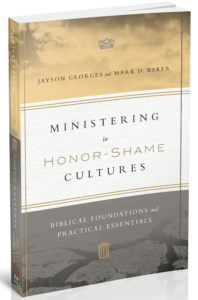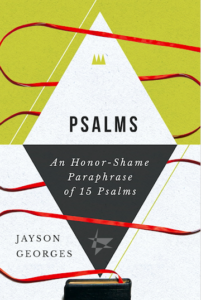My Attempts to Visualize Honor & Shame
I use mostly words to explain honor and shame. I write out my ideas in books, articles, and blogposts. I regret not being more artistic, because honor and shame can also be powerfully communicated visually. On a few occasions, I’ve had the opportunity to represent honor and shame visually.
I consider these visual designs as essential parts of the honor-shame message. Each piece is the result of an intentional design process. This post explains my attempts to visualize honor and shame. Hopefully, this helps you better understand honor and shame and consider non-verbal ways to communicate those concepts
1. The HonorShame.com Logo

The HonorShame.com logo (developed by Josh Feit of www.Evangela.com) was constructed on a grid of 25 equilateral diamonds. The identical shapes—the second rotated 180 degrees from the first—construct a broken letter ‘S’, which is divided by the ‘H’ created in the negative space. The “H”onor breaks apart “S”hame. The two pieces of the “S” are then combined for the background design.
This design broadly invokes the artistic patterns of honor-shame cultures, without being confined to any particular culture. The red tones evoke the color of blood—a rich symbol for both honor and shame.
2. The 3D Gospel
 Every genre has a certain look and feel. You can distinguish a romance novel from a historical biography by observing the fonts, colors, and styles. The cover of ministry books, like The 3D Gospel, often depict the idea of culture, often by showing non-Western faces or something “foreign.” I wanted to depict the diversity of humanity in a dignifying, but not otherizing manner.
Every genre has a certain look and feel. You can distinguish a romance novel from a historical biography by observing the fonts, colors, and styles. The cover of ministry books, like The 3D Gospel, often depict the idea of culture, often by showing non-Western faces or something “foreign.” I wanted to depict the diversity of humanity in a dignifying, but not otherizing manner.
The image combines the dignified profile of six different people: a white/European, a Chinese, a black African, a Middle Easterner, an Indian, and a tribal person. Each of those groups represents around 1 billion people, so together, they roughly represent the global population. Plus, there is balance in regard to gender and age. The gospel is for every person, no exceptions. I purposefully included a Western/European face to show Western culture is one particular culture among others. This affirms the main point of my book—that guilt-theology, shame-theology, and fear-theology are equally valid in Scripture.
I also wanted to illustrate the completeness and wholeness to the gospel. There are not 3 gospels, but 1 three-dimensional gospel. This unity and universality comes together in the single face that is the focal point of the image. The result is a memorable, compelling cover image.
3. Ministering in Honor-Shame Cultures
 The most common visual for honor-shame is a downward-looking or covered face. I hate that visual. It is lazy, clichéd, demeaning, and inaccurate. And even worse, the face is usually an Asian or women, as if white men don’t deal with shame! We wanted to convey honor and shame without locating the concepts in any particular human. David Fassett, IVP’s award-winning designer, hit a homerun with his beautiful visualization of honor and shame.
The most common visual for honor-shame is a downward-looking or covered face. I hate that visual. It is lazy, clichéd, demeaning, and inaccurate. And even worse, the face is usually an Asian or women, as if white men don’t deal with shame! We wanted to convey honor and shame without locating the concepts in any particular human. David Fassett, IVP’s award-winning designer, hit a homerun with his beautiful visualization of honor and shame.
The top portion features the heavens, a place of exaltation and divine glory. The lower part is parched dirt, a symbol of disgrace and death. The cover also has two icons: a crown representing royal honor and a trash meaning worthless and rejected. The colors of royal gold and charcoal gray reinforce these values.
The first mock-up featured a teardrop icon on bottom (instead of the trash can), but we felt that reflected the Western definition of shame (a private emotion) more than the biblical reality (a communal evaluation). The central portion features the title, with special prominence given to the words “Honor-Shame,” our desired focal point. I was happy our author names are on the top portion of the cover and not in the dirt!
4. The Honor-Shame Paraphrase

For this cover, I hired David Fassett of InterVarsity Press. I asked him to illustrate this idea—“cultural insights of the Bible made accessible and engaging.” I wanted the Honor-Shame Paraphrase series cover to feel practical (but not sentimental) like a bible study series, and also insightful (but not academic) like a commentary series.
The bold geometrical shapes communicate the authority and confidence of Scripture. Yet, the red Bible ribbon flowing through the cover shows my paraphrase is not definitive or final. The red ribbon also suggests the Bible is laced with honor and shame.
Regarding the two icons on the picture, the designer David Fassett explained, “Since there is a strong dichotomy involved in the title, I thought it would lend itself well to visual interpretation. The top symbol is intended to allude to a crown or mountains to symbolize honor. The shape at the bottom is playing off the same shapes as the top symbol, only highly distorted/inverted. It’s meant to convey a sense of failure or turmoil. The position of each element is important conceptually too, the top symbolizing raised up/elevated by the group and the bottom symbolizing shame and rejection. I think the bottom shape also feels like a wadded-up piece of paper, which further reinforces the idea.”
These visual elements reflect the social aspects of honor and shame, plus the hermeneutical contrasts of clarity and confusion. These same motifs are echoed by the two contrasting triangles (one right side up and white, the other upside down and black) that fill the front cover. Put together, these elements communicate the aim of the Honor-Shame Paraphrase—accessible biblical insights.
5. My Headshot

I wanted my headshot somehow to play off of the concept of “face.” So, we used darkness to create the effect of being “faceless.” Yet, the emerging light suggests brightness shining on my face as though I am beholding glory face to face.
The picture thus captures both elements of honor and shame. The photographer David Park did a great job with the lighting. In a pitch-black room, I held a flashlight in front of my face while he photographed the back of my head.
Conclusion
I am truly grateful for such talented creators who helped me visually express honor and shame. They did an amazing job using visuals to reinforce the concepts.
As you endeavor to communicate the biblical realities of honor and shame, consider the visual and non-discursive ways you can reinforce your teaching content.

Thanks for your creativity and vulnerability in sharing these concepts…Press On Jayson!
How do you define honor? I this list I never read a clear definition.
Of course, like many other words, honor has various significations, yet the context always determines which is meant: polysemy occurs in all languages.
I propose to define honor universally as: “moral reputation”.
If you are known by others as a morally good person, they are likely to include you as a friend, neighbor, co-worker, classmate, etc. Honor therefore can be linked to pivotal social psychological notions such as inclusion and acceptance.
People who possess honor in their community, are included, also enjoy respect for their competences, skills and characteristics (e.g. hospitality) – yet these are elements of social status (cf. Von Rueden), not of honor.
Yet if people doubt an individual’s morality, they will not include them, but reject them from their company as a spouse, friend, colleague, classmate, neighbor, etc. None will be interested in their skills any longer. They loose respect.
A situation of exclusion and ostracism because of alleged moral deviance is obviously one of dishonor and shame (German: Schande). (Ask for example mr. Weinstein.)
When confronted with of dishonor and shame an individual will probably also feel ashamed. In fact, they are supposed to feel shame (embarrassment, German: Sham) and repent (but nobody knows if they really do) if they ever want to be exonerated and re-accepted in their community.
A situation of dishonor is equivalent to being ostracized, a situation of “social death” (cf. prof. Kipling Williams and many others). Ostracism in all its forms has detrimental effects on one’s well-being and health and can lead to psychiatrical conditions.
In evolutionary terms, ostracism and expulsion by one’s community probably meant physical death as well. Think of Cain who was expelled from his in-group because he killed his brother, but was protected by God.
Being known as a morally good person, does not mean one actually is. People can secretly commit atrocities without anybody finding out, and thus keep enjoying the respect of others and having their social status acknowledged.
Individuals who are known as morally bad, can easily cast a serious moral stigma on their affiliates. Think for example of the children of war criminals, the parents of school shooters in the US and relatives of RSO’s.
Relatives of morally deviant individuals are often in their community asked whether they knew anything about the deed; they are also forced to publicly reconsider their relationship with their deviant group member (cf. Condry, Families Shamed).
When Peter was asked whether he knew Jesus, he denied their relationship. Jesus forgave him, because he understood that if the Romans had known about their affiliation, the stigma-by-association upon Jesus and all Apostles could easily have lead to Peter’s death.
The dichotomy of honor and shame cultures (introduced by Ruth Benedict in 1946, not on field work, to be sure, but as a theoretical exercise on Japan), often discussed in this list, has been abandoned a long time ago in social psychology.
The reason is that experiments since 1946 have time and again shown that people’s behavior does not differ that much, certainly not enough to justify this dichotomy of shame and honor cultures. Instead, individuals, regardless of their cultural background, respond similarly in similar contexts.
However, there are differences related to what individuals consider as moral deviance, which does not depend on their culture but on the moral norms of their communities.
For example, in some communities in the US, abortion is considered a type of murder. In other words: in those communities, abortion is thought of as a transgression of an important moral norm. People from those communities tend to label women who have an abortion as well as medical doctors who carry out abortion operations as murderers. In other communities in the US abortion is much less considered a moral issue. The moral norms values of these communities obviously conflict with one another.
The mechanism of inclusion and exclusion – for moral or other reasons – is universal, it has even found in primates (cf. De Waal). It is of all times.
I reckon it can be interesting and inspirational to read mind biblical texts with this in mind.
Interested? Read Ermers, Honor Related Violence, 2018.